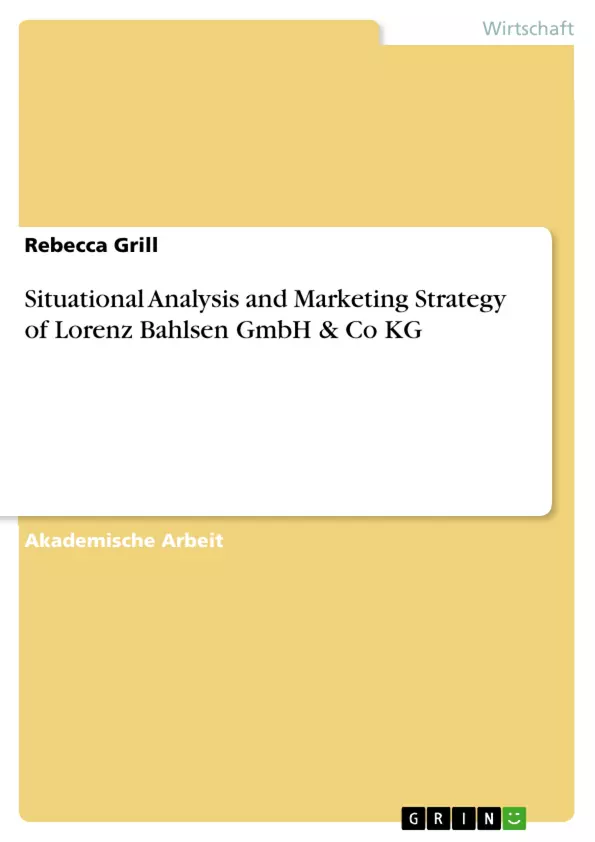This report introduces the Lorenz Bahlsen Snack-World GmbH & Co KG Germany and analysis its recent situation, as well as its marketing strategy.
In this context, one of their product lines is taken in consideration in more detail. Special advantages of its products and potential objectives are represented. The marketing strategy is the decisive factor of the success of an organisation. This is why it is essential to analyse strategies and to figure out new indications, as markets change continues.
The Lorenz Bahlsen Snack-World GmbH & Co KG Germany is an international manufacturer of savoury snacks, such as potato crisps, pretzel snacks and nuts. 1999 it was founded in Neu-Isenburg, Germany and was named after its founder Lorenz Bahlsen. The company distributes its products to around 80 countries worldwide. Manufacturing sites and sales organisations have been established in Germany, Poland, Austria and Russia.
In 2014 the market share of the company Lorenz decreased to 13%, comparing to ca. 14% in 2011, showing that the company's marketing strategy needs a revision. Lorenz distributes 19 different product lines with a large portion of crisps. One of their product lines is the well-known brand "Saltletts". This year the brand celebrates its 80 birthday.
1935 it offered the first pretzel stick in Germany under the name "Salzletten". Saltletts offers different kinds of pretzel sticks, which distinct in shape and taste. Altogether Saltletts disposes of eleven products that distinguish in shape, size, flavour and toppings.
Inhaltsverzeichnis
- Executive summary
- Task 1 & 2
- 1 Introduction
- 2 Situational Analysis
- 2.1 PESTLE-Analysis
- 2.2 SWOT-Analysis
- 3 Assessment / evaluation of current marketing strategy
- 4 Differential advantages, competitive edge (USP)
- 5 Segmentation Targeting & Positioning (STP)
- 6 Recommended objectives and goals (SMART)
- 7 Recommended Marketing Strategies and Programmes
- 8 Conclusion
- List of Works Cited
Zielsetzung und Themenschwerpunkte
Dieser Bericht analysiert die Lorenz Bahlsen Snack-World GmbH & Co KG Germany und ihre aktuelle Marktsituation, einschließlich ihrer Marketingstrategie. Der Fokus liegt dabei auf einer bestimmten Produktlinie und deren besonderen Vorzügen sowie möglichen Zielen.
- Analyse der aktuellen Marktsituation von Lorenz Bahlsen Snack-World GmbH & Co KG Germany
- Bewertung der aktuellen Marketingstrategie
- Identifizierung von Wettbewerbsvorteilen (USP)
- Entwicklung von Empfehlungen für Marketingziele und -strategien
- Bewertung der Auswirkungen von PESTLE- und SWOT-Analysen auf die Marketingstrategie
Zusammenfassung der Kapitel
- Kapitel 1: Einführung: Dieser Abschnitt stellt die Lorenz Bahlsen Snack-World GmbH & Co KG Germany vor, ihre Geschichte, Produktpalette und aktuelle Marktsituation.
- Kapitel 2: Situationsanalyse: In diesem Kapitel werden die relevanten Faktoren der Unternehmensumgebung mithilfe einer PESTLE-Analyse untersucht. Darüber hinaus werden Stärken, Schwächen, Chancen und Risiken von Lorenz mithilfe einer SWOT-Analyse ermittelt.
Schlüsselwörter
Die Analyse der Lorenz Bahlsen Snack-World GmbH & Co KG Germany konzentriert sich auf die Bereiche Marketingstrategie, Situationsanalyse, PESTLE-Analyse, SWOT-Analyse, Wettbewerbsvorteile, Zielsetzung und Marketingprogramme. Wichtige Themen sind die Entwicklung von Strategien für den Erfolg in einem sich verändernden Marktumfeld und die Anpassung von Produkten und Marketingaktivitäten an aktuelle Trends und Bedürfnisse der Kunden.
- Quote paper
- Rebecca Grill (Author), 2015, Situational Analysis and Marketing Strategy of Lorenz Bahlsen GmbH & Co KG, Munich, GRIN Verlag, https://www.grin.com/document/468819



